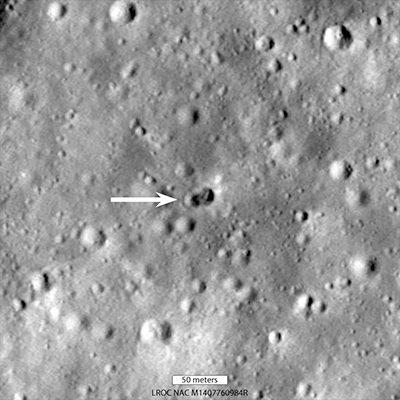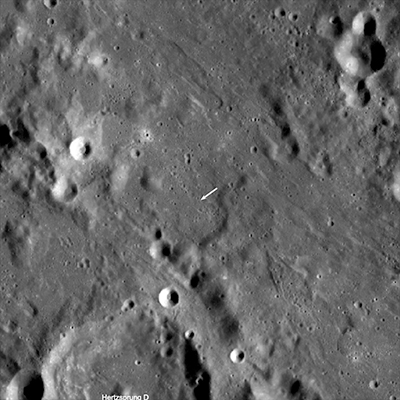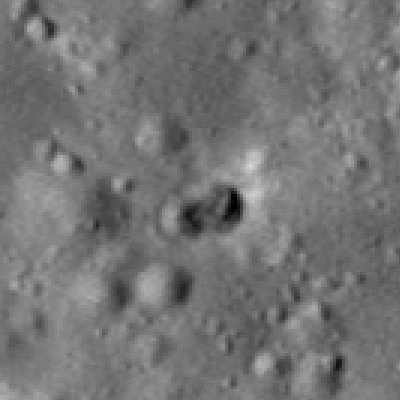|
|

|
|
Author
|
Topic: Spent rocket stage impacts moon (3.4.22)
|
Robert Pearlman
Editor Posts: 48588
From: Houston, TX
Registered: Nov 1999
|
 posted 01-24-2022 03:49 PM
posted 01-24-2022 03:49 PM
   
The SpaceX Falcon 9 second stage that helped launch NOAA's Deep Space Climate Observatory in February 2015 is now on course to intersect the moon, Ars Technica reports. According to Bill Gray, who writes the widely used Project Pluto software to track near-Earth objects, asteroids, minor planets, and comets, such an impact could come in March.Earlier this month, Gray put out a call for amateur and professional astronomers to make additional observations of the stage, which appears to be tumbling through space. With this new data, Gray now believes that the Falcon 9's upper stage will very likely impact the far side of the Moon, near the equator, on March 4. More information can be found here. Some uncertainties remain. As the object is tumbling, it is difficult to precisely predict the effects of sunlight "pushing" on the rocket stage and thus making slight alterations to its orbit. "These unpredictable effects are very small," Gray writes. But they will accumulate between now and March 4, and further observations are needed to refine the precise time and location of the impact. |
oly
Member Posts: 1393
From: Perth, Western Australia
Registered: Apr 2015
|
 posted 01-24-2022 05:49 PM
posted 01-24-2022 05:49 PM
   
If this rocket body hits an existing "historically significant human or robotic landing sites, artifacts, spacecraft, and other evidence of activity," does this mean that the U.S. would be the first nation to break the Artemis Accords? |
Robert Pearlman
Editor Posts: 48588
From: Houston, TX
Registered: Nov 1999
|
 posted 01-24-2022 07:55 PM
posted 01-24-2022 07:55 PM
   
No, because the launch preceded the Artemis Accords by five years.But let's hope the predictions remain true and the impact point is on the far side and near the equator. |
Robert Pearlman
Editor Posts: 48588
From: Houston, TX
Registered: Nov 1999
|
 posted 02-12-2022 10:25 PM
posted 02-12-2022 10:25 PM
   
A Falcon 9 rocket stage is not going to strike the moon next month. Instead, it's probably a Chinese rocket, Ars Technica reports. Bill Gray, who writes the widely used Project Pluto software to track near-Earth objects and was the original source for the Falcon 9 hitting the Moon story, acknowledged the error on his website Saturday. He explained that, back in 2015, he and other observers found an unidentified object in the sky and gave it a temporary name, WE0913A. Further observations suggested it probably was a human-made object, and soon the second stage of the rocket used to launch DSCOVR became a prime candidate."I thought it was either DSCOVR or some bit of hardware associated with it," Gray wrote Saturday. "Further data confirmed that yes, WE0913A had gone past the moon two days after DSCOVR's launch, and I and others came to accept the identification with the second stage as correct. The object had about the brightness we would expect, and had showed up at the expected time and moving in a reasonable orbit." ... It was an engineer at NASA's Jet Propulsion Laboratory, Jon Giorgini, who realized this object was not in fact the upper stage of a Falcon 9 rocket. He wrote to Gray on Saturday morning explaining that the DSCOVR spacecraft's trajectory did not go particularly close to the Moon, and that it would therefore be a little strange if the second stage strayed close enough to strike it. This prompted Gray to dig back into his data, and identify other potential candidates. He soon found one — the Chinese Chang'e 5-T1 mission launched in October 2014 on a Long March 3C rocket. This lunar mission sent a small spacecraft to the Moon as a precursor test for an eventual lunar sample return mission. The launch time and lunar trajectory are almost an exact match for the orbit of the object that will hit the Moon in March. |
Robert Pearlman
Editor Posts: 48588
From: Houston, TX
Registered: Nov 1999
|
 posted 02-21-2022 01:11 PM
posted 02-21-2022 01:11 PM
   
Rocket debris set to impact the moon in March does not originate from the 2014 Chang'e-5 T1 mission, China's Ministry of Foreign Affairs claims. "According to China's monitoring, the upper stage of the rocket related to the Chang'e-5 mission entered into Earth's atmosphere and completely burned up," Foreign Ministry spokesperson Wang Wenbin said Feb. 21.Space tracking data from the Space Force's 18th Space Control Squadron suggests that 2014-065B — the international designator for the rocket stage in question — reentered the atmosphere in October 2015, a year after launch, apparently backing China's claim. |
Robert Pearlman
Editor Posts: 48588
From: Houston, TX
Registered: Nov 1999
|
 posted 06-24-2022 09:47 AM
posted 06-24-2022 09:47 AM
   
NASA release NASA's Lunar Reconnaissance Orbiter Spots Rocket Impact Site on MoonAstronomers discovered a rocket body heading toward a lunar collision late last year. Impact occurred March 4, with NASA's Lunar Reconnaissance Orbiter later spotting the resulting crater. Surprisingly the crater is actually two craters, an eastern crater (18-meter diameter, about 19.5 yards) superimposed on a western crater (16-meter diameter, about 17.5 yards).  Above: A rocket body impacted the Moon on March 4, 2022, near Hertzsprung crater, creating a double crater roughly 28 meters wide in the longest dimension. LROC NAC M1407760984R; image enlarged 3x. (NASA/Goddard/Arizona State University) The double crater was unexpected and may indicate that the rocket body had large masses at each end. Typically a spent rocket has mass concentrated at the motor end; the rest of the rocket stage mainly consists of an empty fuel tank. Since the origin of the rocket body remains uncertain, the double nature of the crater may indicate its identity.  Above: The crater formed (5.226 degrees north, 234.486 degrees east, 1,863 meters elevation) in a complex area where the impact of ejecta from the Orientale basin event overlies the degraded northeast rim of Hertzsprung basin (536 kilometers diameter). The new crater is not visible in this view, but its location is indicated by the white arrow. LROC WAC mosaic, 110 kilometers width. (NASA/Goddard/Arizona State University) No other rocket body impacts on the Moon created double craters. The four Apollo SIV-B craters were somewhat irregular in outline (Apollos 13, 14, 15, 17) and were substantially larger (greater than 35 meters, about 38 yards) than each of the double craters. The maximum width (29 meters, about 31.7 yards) of the double crater of the mystery rocket body was near that of the S-IVBs.  Above: These four images show craters formed by impacts of the Apollo SIV-B stages: crater diameters range from 35 to 40 meters (38.2 to 43.7 yards) in the longest dimension. (NASA/Goddard/Arizona State University) |
Headshot
Member Posts: 1083
From: Vancouver, WA, USA
Registered: Feb 2012
|
 posted 06-24-2022 10:18 AM
posted 06-24-2022 10:18 AM
   
To me that does not look like a double crater, but merely one crater next to another (probably preexisting) crater.The crater made by the rocket is on the right side and features a ray system. The left crater has no rays that I can detect. Also, the right crater's wall (faint but still there) extends slightly into the left crater. If these craters were made by one object, even with substantial masses at each end, there would be no wall at all. I think the jury is still out until we obtain higher resolution imagery. |
Robert Pearlman
Editor Posts: 48588
From: Houston, TX
Registered: Nov 1999
|
 posted 06-24-2022 11:55 AM
posted 06-24-2022 11:55 AM
   
This animation shows that neither crater was there prior to the impact: |
stsmithva
Member Posts: 2043
From: Fairfax, VA
Registered: Feb 2007
|
 posted 06-24-2022 01:51 PM
posted 06-24-2022 01:51 PM
   
On the one hand, I'm happy that there are so many rocket launches in recent years; but on the other, it's downright weird that people spotted the debris on the way to the moon and could therefore do the math to figure out its approximate launch date, but it's still not clear what rocket it was. So far, specific missions have been ruled out. Is it possible that there was a classified lunar mission? I don't lunge for conspiracy theories, but there are only a certain few publicly-known things that big that escaped Earth orbit, and as I say it's weird that so far it's only been, "Nope, not that one. Nope, not that one." |
Headshot
Member Posts: 1083
From: Vancouver, WA, USA
Registered: Feb 2012
|
 posted 06-24-2022 03:52 PM
posted 06-24-2022 03:52 PM
   
I stand corrected.This is one of the most unusual set of double craters that I have seen. | |
Contact Us | The Source for Space History & Artifacts
Copyright 2022 collectSPACE.com All rights reserved.

Ultimate Bulletin Board 5.47a
|
|

|
 advertisement advertisement

|















